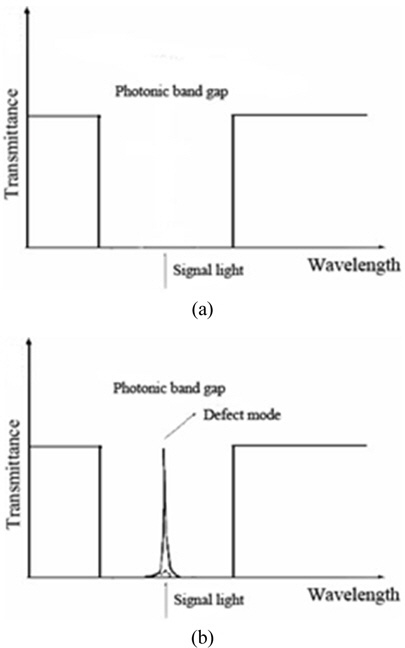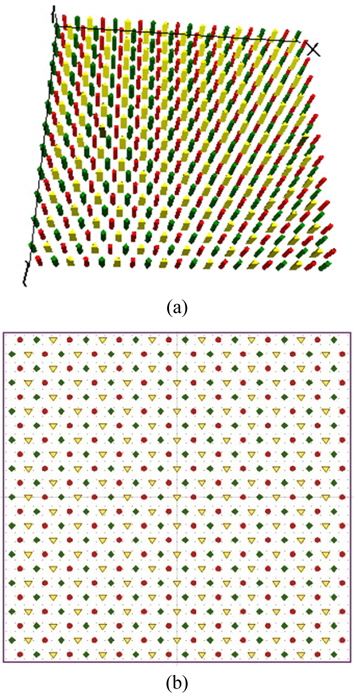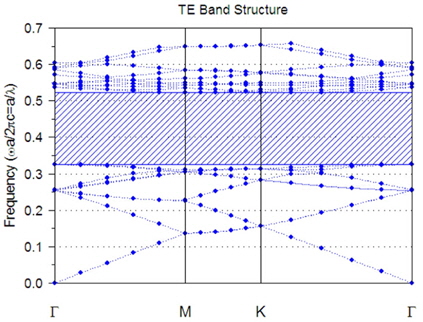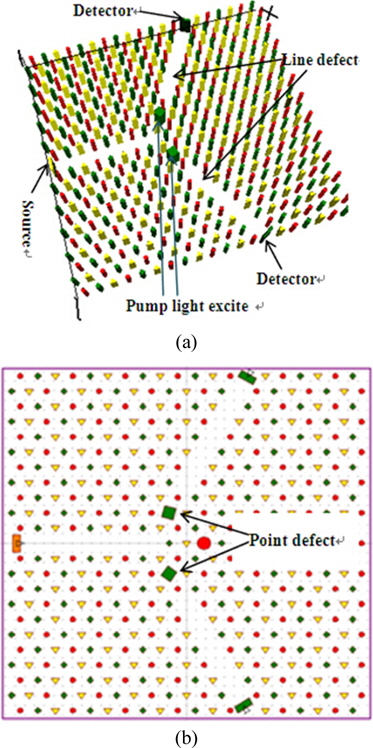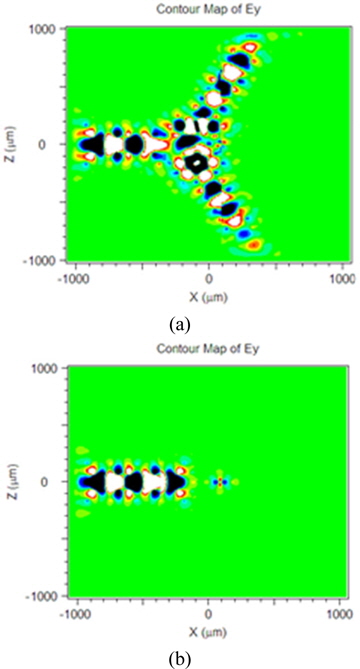



Nowadays the demand for broadband data communication is growing rapidly, owing to the information explosion. Optical communications systems have been researched for a long time, and the study of THz communications systems has become an inevitable trend. The THz modulator is one of the key devices in a THz communications system. Recently, there has been growing interest in studying THz wave modulators, especially multi wavelength THz modulators [1-3]. Currently dual-wavelength and four-wavelength THz modulators based on a compound-lattice photonic crystal (PC) have been proposed [4, 5]. A novel type of six-wavelength THz modulator based on a triple-lattice photonic crystal is proposed in this paper.
As is well known, various methods may be used to realize THz wave modulation [6, 7]. The PC material plays an important role in a THz modulator because of its excellent characteristics and production technology [8, 9]. A PC has the characteristics of a photonic band gap (PBG) and photon localization [10, 11]. A high-efficiency, controllable multi wavelength photonic crystal modulator can be fabricated by using a PC with defects. Using the disappearing-defect-mode theory, we have designed a six-wavelength THz modulator that has the advantages of high extinction ratio and low insertion loss.
Defect-mode disappearance is based on the photon-localization characteristic of a PC. This characteristic of a PC is due to the combination of both point and line defects. Line defects are introduced as waveguides to transmit THz wave with frequencies located in the PBG, while point defects are used as resonant cavities, in which only THz frequencies in accord with the resonant frequency (or defect-mode frequency) can be selected. Figure 1 is a schematic diagram of the modulation based on defect-mode disappearance. When the point defects are filled with a tunable material and the pump light is applied to the point defects, the refractive index of the material will change and the defect modes of the point defects will disappear. Therefore, the input THz wave cannot resonate in the cavity and the modulator is in the “off” state, as shown in Fig. 1(a). However, if there is no pump light, the THz wave will resonate in the cavity and the modulator is in the “on” state, as shown in Fig. 1(b) [12, 13].
III. STRUCTURAL DESIGN AND PERFORMANCE ANALYSIS
A triple-triangular-lattice PC is composed of three triangular-lattice photonic crystals, including circular, square, and triangular dielectric cylinders. Figure 2 shows the lattice structure of the PC. Its structural parameters are: lattice constant
The band structure of this triple-triangular-lattice PC for TE waves, as calculated by the plane-wave method (PWM), is shown in Fig. 3.
The shaded part in Fig. 3 is the PBG. The normalized frequency
To achieve multi wavelength modulation, two point defects and two line defects are introduced into the photonic crystal at the same time, as shown in Fig. 4. The point defects and line defects are directly coupled.
The tunable material used in the point defects is gallium arsenide (GaAs), for which the THz refractive index in the photo-excited condition is complex and defined as
In Fig. 4 the width of the upper square point defect is
Figure 5 displays the simulation results for the transmission spectrum. Six beams of the THz wave propagate through the modulator when the modulator is in “on” state, as shown. Each square point defect can modulate three beams of the THz wave. The wavelengths of the three defect modes produced by the upper square point (blue line) are 197.86 μm, 205.64 μm, 222.91 μm respectively. The wavelengths of the three defect modes produced by the lower square point (green line) are 191.67 μm, 200.92 μm, 216.82 μm respectively. The sum of the numbers of defect modes produced by upper and lower square points is six.
For the case of the six beams of the THz wave being incident simultaneously, the extinction ratio and insertion loss of the modulator are analyzed in detail below. From Fig. 5, the six incident wavelengths are set as 191.67 μm, 197.86 μm, 200.92 μm, 205.64 μm, 216.82 μm, and 222.91 μm respectively. All of the incident THz waves are Gaussian and continuous.
The extinction ratio is an important index to evaluate the capacity of modulation. The time-domain steady-state response is shown in Fig. 6. As registered by the upper detector in Fig. 4, Figs. 6(a) and 6(b) show the “on” and “off” states of the modulator respectively. As registered by the lower detector in Fig. 4, Figs. 6(c) and 6(d) show the “on” and “off” states of the modulator respectively.
The definition of extinction ratio is
where
The definition of insertion loss is
where
The definition of the modulation rate is
where
The steady-state THz wave field intensity distributions of in “on” (
Figure 7 shows that the six beams of the THz wave were modulated effectively by the multi-wavelength photonic-crystal THz modulator with a large extinction ratio.
The simulation results show that this novel multi wavelength photonic-crystal THz modulator can effectively modulate a THz wave, with large extinction ratio and low insertion loss.
A novel multi wavelength THz modulator based on a triple-triangle-lattice-structure photonic crystal is proposed. By changing the GaAs refractive index, the modulation of six wavelengths (191.67 μm, 197.86 μm, 200.92 μm, 205.64 μm, 216.82 μm, and 222.91 μm) can be realized. The extinction ratio is as large as 34.25 dB, the insertion loss as low as 0.147 dB, and the modulation rate 2.35 GHz. This modulator presents a theoretical foundation for research in communications devices for the THz range, and can also meet the requirements of future THz wave communications systems better.
